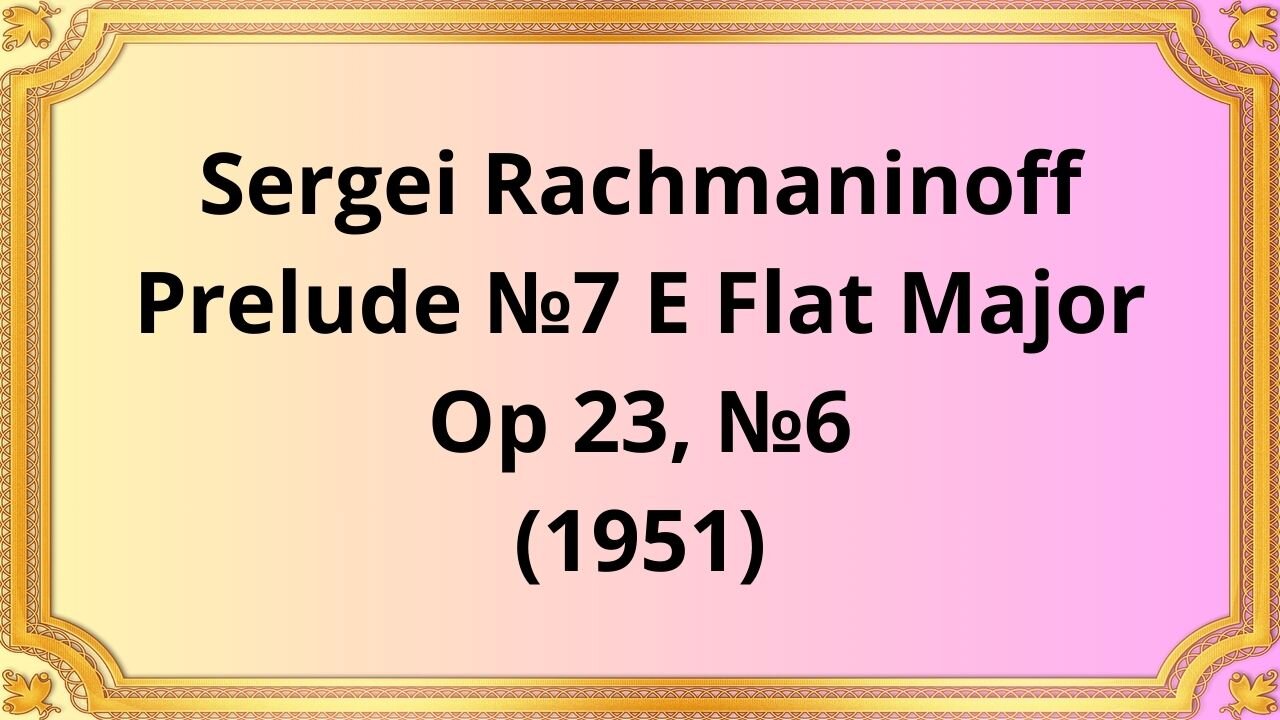Premium Only Content

Sergei Rachmaninoff Prelude №7 E Flat Major, Op 23, №6 (1951)
#SergeiRachmaninoff #classicalmusic #PreludeNo7 #EFlatMajor #Op23No6 #musicalcomposition #Russiancomposer #piano #emotionaldepth #virtuosity
Publication date 1951
Dame Moura Lympany
Sergei Rachmaninoff, a renowned Russian composer and pianist, left an indelible mark on the world of classical music. His Prelude No. 7 in E Flat Major, Op. 23, No. 6 is a captivating composition that showcases his exceptional talent and musical prowess.
Rachmaninoff composed the Prelude No. 7 in E Flat Major as part of his opus 23, a collection of ten preludes for solo piano. Completed in 1903, this piece is characterized by its rich harmonies, virtuosic passages, and expressive melodies. It stands as a testament to Rachmaninoff's mastery of the piano and his ability to evoke a wide range of emotions through his compositions.
The Prelude No. 7 is structured in a traditional ternary form, consisting of three distinct sections: an opening statement, a contrasting middle section, and a recapitulation of the initial material. The piece begins with a lyrical melody introduced in the right hand, accompanied by arpeggiated chords in the left hand. The middle section provides a contrasting theme, often characterized by more dramatic and intense passages. The recapitulation brings back the initial melody, sometimes with variations, before building towards a powerful and triumphant conclusion.
Rachmaninoff's Prelude No. 7 is imbued with a wide range of emotions. The opening section establishes a sense of longing and nostalgia, with its melancholic melody and delicate harmonies. As the piece progresses, the middle section introduces a more turbulent and passionate theme, filled with cascading runs and dramatic chord progressions. The contrast between the two sections creates a compelling narrative, evoking feelings of both introspection and intensity. The final recapitulation combines elements from both sections, leading to a cathartic resolution that leaves the listener with a sense of fulfillment and awe.
Rachmaninoff's Prelude No. 7 showcases his exceptional technical skills as a pianist. The piece demands a high level of virtuosity, with intricate passages, rapid arpeggios, and complex chord voicings. The pianist must navigate challenging fingerings and maintain a delicate balance between the melodic lines and accompanying harmonies. Playing this piece requires both technical precision and a deep understanding of the emotional nuances embedded within the composition.
Rachmaninoff's Prelude No. 7 is widely regarded as one of his most beloved and iconic compositions. Its emotional depth, technical brilliance, and melodic beauty have captivated audiences for over a century. The piece continues to be performed and admired by pianists and music enthusiasts worldwide, serving as a testament to Rachmaninoff's enduring legacy as a composer.
Sergei Rachmaninoff's Prelude No. 7 in E Flat Major, Op. 23, No. 6 is a remarkable musical work that exemplifies the composer's mastery of the piano and his ability to evoke profound emotions. Through its structural elements, musical themes, and technical challenges, this composition stands as a testament to Rachmaninoff's exceptional talent and enduring legacy. Listening to this masterpiece allows us to embark on a captivating musical journey, filled with longing, passion, and triumph.
You have the opportunity to support the channel:
https://destream.net/live/RadSiarAl/donate
https://www.buymeacoffee.com/6355radsiaral
-
 LIVE
LIVE
Game On!
7 hours agoThe NFL has an officiating problem after the WORST MNF game of all time!
370 watching -
 LIVE
LIVE
LFA TV
9 hours agoDebt Tuesday: Trump: More Tariffs on Canada, Mexico, China | WORLD HD 11.26.24 @8am EST
426 watching -
 1:05:00
1:05:00
Part Of The Problem
10 hours agoDave Smith | Trust the Science | Part Of The Problem 1196
25.3K22 -
 13:58
13:58
Tactical Advisor
16 hours agoBudget vs Expensive Shotgun
13.8K4 -
 14:19
14:19
justintech
12 hours ago $1.97 earnedBest Gaming PC Under $2000 - In 2024
8.07K6 -
 5:09
5:09
Guns & Gadgets 2nd Amendment News
21 hours agoFBI Stops 9/11 Style Terror Attack!!
9.03K8 -
 9:39
9:39
GBGunsRumble
21 hours agoGBGuns Armory Ep 128 Kimber R7 Mako Carbon Compact
44.6K8 -
 1:00:51
1:00:51
The Tom Renz Show
19 hours ago"DEI Is Racist - Who knew & Redfield Now Worries About COVID Jabs"
53.5K7 -
 5:01
5:01
BIG NEM
12 hours agoInside the Albanian Mob... As a Serb.
25.7K2 -
 1:40:14
1:40:14
TheConnieBryanShow
4 days agoGAIN OF FUNCTION: MRNA, D.A.R.P.A. & THE PFIZER PAPERS
21.4K5